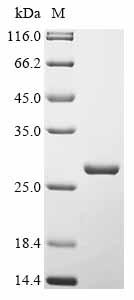Recombinant Mouse Gasdermin-A3 (Gsdma3) , partial
CAT:
399-CSB-EP730416MO1-02
Size:
100 µg
Price:
Ask
- Availability: 24/48H Stock Items & 2 to 6 Weeks non Stock Items.
- Dry Ice Shipment: No




Recombinant Mouse Gasdermin-A3 (Gsdma3) , partial
- CAS Number: 9000-83-3
- Gene Name: Gsdma3
- UniProt: Q5Y4Y6
- Expression Region: 263-464aa
- Organism: Mus musculus
- Target Sequence: MHEDFKTLKEEVQRETQEVEKLSPVGRSSLLTSLSHLLGKKKELQDLEQKLEGALDKGQKVTLEALPKDVLLSKDAMDAILYFLGALTELTEEQLKILVKSLEKKILPVQLKLVESTLEQNFLQDKEGVFPLQPDLLSSLGEEELTLTEALVGLSGLEVQRSGPQYAWDPDTRHNLCALYAGLSLLHLLSRKSNALTYCALS
- Tag: N-terminal 6xHis-tagged
- Source: E.coli
- Field of Research: Others
- Assay Type: In Stock Protein
- Relevance: [Gasdermin-A3]: Precursor of a pore-forming protein involved in the transition from catagen to telogen at the end of hair follicle morphogenesis. This form constitutes the precursor of the pore: upon cleavage, the released N-terminal moiety (Gasdermin-A3, N-terminal) binds to membranes and forms pores, triggering cell death. ; [Gasdermin-A3, N-terminal]: Pore-forming protein that causes membrane permeabilization and pyroptosis. Released upon cleavage in vitro of genetically engineered Gsdma3, and binds to membrane inner leaflet lipids. Homooligomerizes within the membrane and forms pores of 10-15 nanometers (nm) of inner diameter, allowing the release of mature interleukin-1 (IL1B and IL18) and triggering pyroptosis. Binds to membrane inner leaflet lipids, including bisphosphorylated phosphatidylinositols, such as phosphatidylinositol (4, 5)-bisphosphate, as well as phosphatidylinositol (3, 4, 5)-bisphosphate, and more weakly to monophosphorylated phosphatidylinositols. Also binds to bacterial and mitochondrial lipids, including cardiolipin, and exhibits bactericidal activity. The functional mechanisms and physiological proteases that cleave and activate this pore-forming protein are unknown (Probable). Plays a role in the transition from catagen to telogen at the end of hair follicle morphogenesis, possibly by regulating hair follicle stem cell niche maintenance. Also required for mammary gland development.
- Purity: Greater than 90% as determined by SDS-PAGE.
- Activity: Not Test
- Length: Partial
- Form: Liquid or Lyophilized powder
- Buffer: If the delivery form is liquid, the default storage buffer is Tris/PBS-based buffer, 5%-50% glycerol. If the delivery form is lyophilized powder, the buffer before lyophilization is Tris/PBS-based buffer, 6% Trehalose, pH 8.0.
- Reconstitution: We recommend that this vial be briefly centrifuged prior to opening to bring the contents to the bottom. Please reconstitute protein in deionized sterile water to a concentration of 0.1-1.0 mg/mL.We recommend to add 5-50% of glycerol (final concentration) and aliquot for long-term storage at -20℃/-80℃. Our default final concentration of glycerol is 50%. Customers could use it as reference.
- Molecular Weight: 26.6 kDa
- References & Citations: "The dominant alopecia phenotypes Bareskin, Rex-denuded, and Reduced Coat 2 are caused by mutations in gasdermin 3." Runkel F., Marquardt A., Stoeger C., Kochmann E., Simon D., Kohnke B., Korthaus D., Wattler F., Fuchs H., Hrabe de Angelis M., Stumm G., Nehls M., Wattler S., Franz T., Augustin M. Genomics 84:824-835 (2004)
- Storage Conditions: The shelf life is related to many factors, storage state, buffer ingredients, storage temperature and the stability of the protein itself. Generally, the shelf life of liquid form is 6 months at -20℃/-80℃. The shelf life of lyophilized form is 12 months at -20℃/-80℃.
